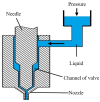Simulation and Experiment on Droplet Formation and Separation for Needle-Type Micro-Liquid Jetting Dispenser
- PMID: 30424263
- PMCID: PMC6082297
- DOI: 10.3390/mi9070330
Simulation and Experiment on Droplet Formation and Separation for Needle-Type Micro-Liquid Jetting Dispenser
Abstract
The needle-type droplet jetting dispenser has wide applications in the field of microelectronic packaging, and for which the good quality of droplet formation and separation is the key to successful dispensing. This paper simulates the droplet jetting process which has been divided into 5 stages named backflow, growth, droplet extension, breakage, and separation, and analyses the combined effects of system parameters, such as pressure, viscosity, needle stroke, and nozzle diameter, on the changes of morphologies of ejected droplets, which is verified by experiments. The simulation and experiment results show that a higher driving pressure is quite suitable for the high-viscosity liquid to form normal droplets by avoiding adhesion. When increasing the needle stroke, the pressure should also be lowered properly to prevent the flow-stream. Besides, the nozzle with a large diameter is much more likely to cause sputtering or satellite-droplet problems. The results have a great significance for guiding the parameter settings of the needle-type dispensing approach.
Keywords: droplet; needle-type; non-contact dispensing; piezoelectric actuator.
Conflict of interest statement
The authors declare no conflict of interest.
Figures















References
-
- Yao Y.F., Lu S.Z., Liu Y.X., Sun L.N. Research on automated micro-liquid dispensing technology. J. Mech. Eng. 2013;14:140–153. doi: 10.3901/JME.2013.14.140. - DOI
-
- Jeon J., Hong S., Choi M., Choi S. Design and performance evaluation of a new jetting dispenser system using two piezostack actuators. Smart Mater. Struct. 2015;24:11. doi: 10.1088/0964-1726/24/1/015020. - DOI
-
- Urano M., Sakata T., Shimamura T., Ishii H., Chino M., Shimada T., Tazawa H., Machida K. Novel Packaging Technology for Microelectromechanical-System Devices. Jpn. J. Appl. Phys. Part 1. 2005;44:8177–8181. doi: 10.1143/JJAP.44.8177. - DOI
-
- Kumagai K., Fuchiwaki O. A Development of Dispenser for High-Viscosity Liquid and Pick and Place of Micro Objects Using Capillary Force. Key Eng. Mater. 2012;516:48–53. doi: 10.4028/www.scientific.net/KEM.516.48. - DOI
Grants and funding
LinkOut - more resources
Full Text Sources
Other Literature Sources

